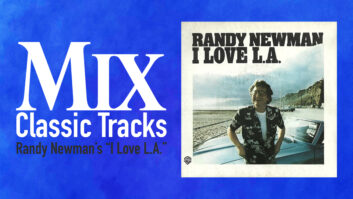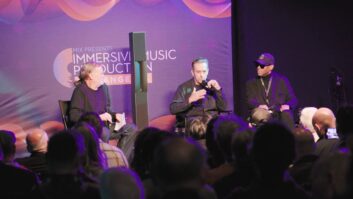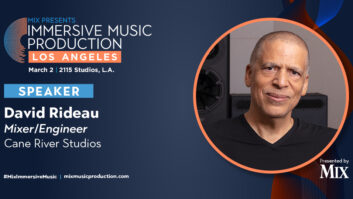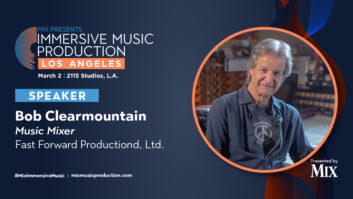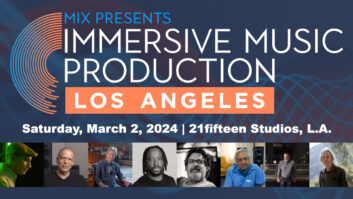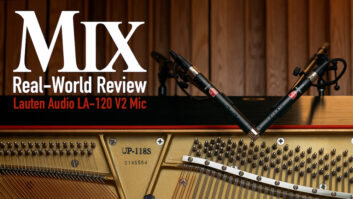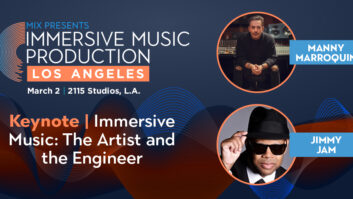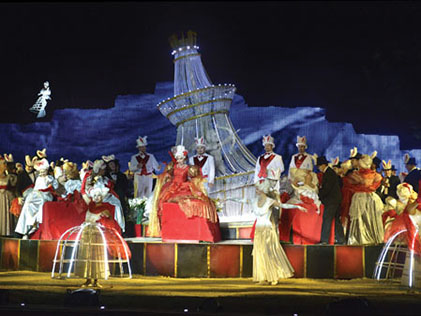
When Giuseppe Verdi penned his classic opera “La Traviata” in the middle of the 19th century, it’s unlikely that he considered the possibility that this work, which details the fall of a trollop with a golden heart, would one day be staged in the foothills of Mt. Masada, where followers of Herod the Great had mounted their own epic performance several millennia earlier.
Under the baton of Daniel Oren, in June of 2014 the Israel Philharmonic delivered this masterpiece beneath the stars to packed houses over the course of a four-night run. Setting up the stage, seating, and a first-class sonic environment under the conditions that the crew of Kilim Pro Sound & Light faced was a massive undertaking. Guided by General Manager Meir Kilim, the son of the company’s founder, the organization did a remarkable job. Mixing tasks were overseen by Yuval Silberstein, who spoke to Mix at some length during the three days that we spent covering the final days of setup, the dress rehearsal and opening night.
From the name of your company, Yuval Sound Ltd., it sounds like you’re a one-man shop.
Yes! I’ve been an audio engineer for about 30 years. Meir’s [Kilim] father taught me the basics—which cables to use, how to repair cables, everything about live mixing in particular. I was a P.A. engineer when I was in the army. When I got out, I became an assistant engineer, and about 18 months later I was working on my first album.
Is there a style of music you feel most comfortable working in?
No, not really. I do a lot of producing these days, and it’s all about the relationship I have with an artist. Things are different in Israel, smaller. There’s a group, Teapacks, that I began working with in the early ’90s who are now making a comeback. People here come from many different cultures, both Eastern and Western. This group is combining a lot of these influences. I was like a secret member of Teapacks. I wasn’t in the photos, but I was involved with the music and vocal production.
Do you work out of your own project studio?
Yes. I have a Pro Tools HD3 system and do most of my mixing and mastering in my studio. We’ve also got a live room in this facility. When I have to work outside of my space, I have a rack of stuff—Pultecs, UREIs, Genelecs, in particular—that I carry with me. I mix entirely within the box at this point. I used to go to a studio that had an SSL console, but after a while I bought a PreSonus ADL 600 and fell in love with its tube sound. I brought it here to Masada, in fact.

Mixer Yoval Silberstein at the Innovason Eclipse GT FOH console.
In the studio you’ll often find engineers poring over scores while working on a classical project. Do you?
I don’t have a background in classical music and don’t read scores. I think sound is very easy to understand if you know the way it works. It doesn’t matter what you’re mixing, that’s my opinion. Low end, low mid, high mid, high. If it’s classical, pop or an Arabian orchestra, the various bands have to make sense and mesh well together. I’ve been associated with the Israeli orchestra for about 10 years and that approach seems to be working!
When you’re working with a rock band you have to ride levels and think about delays and so forth. When mixing a live classical project like “La Traviata at Masada,” don’t you leave more of the “mixing” in the hands of the conductor?
No, I don’t think so. We’re riding a lot with this project. There are differences, to be sure. In a rock project everything moves quickly. You have to react to tempos that can change suddenly. Everything—tempi, changes in orchestration, even the performer’s emotions—changes more slowly. When I let other mixers who have never mixed an opera deal with soloists, their first reaction is generally, “Whoa!” Things jump away from you if you move as you would in a rock concert.
What’s the challenge that mixing in an open space without reflective surfaces brings to a project like this?
You have to build your own concept of sound. For starters, people are not used to hearing opera or classical music in open air. You have to let them imagine that they’re in an opera house. But it’s tricky. When you’re in an opera house you might use just two, or maybe four microphones. Here in the desert, I need many more because I have to control everything. As a result, you have to deal with phases between the microphones; every reflection on every mic can become bigger, so you have to be very careful in the way you handle delays. It’s not an easy job.
Do you use a combination of delays and reverbs?
I only use one reverb, a Lexicon 300. It goes across everything, that’s my glue. It’s not on the master; I send different sends from every channel. Some of the mics I don’t want to be too fat. The concept is to let people try to hear it as close as possible to the sound of an opera house even though it’s outside.
Do you find that there’s ever an artistic conflict between your way of hearing things and the conductor’s? Aren’t you a second conductor of sorts?
I always tell the artists I work with that I’m their player. They’re playing and I’m playing them. Yesterday, the conductor conducted one way and today it will be different. It’s like you have to mix in a different way every night.
In a sense you’re producing the conductor.
Yes, absolutely. [Conductor] Daniel Oren and I spoke about this yesterday. There was some tension between us on the day he arrived from Paris, but things have gotten easier. I’m going to tell him what I think and hear!
For example, during the whole first half of the opera he told the violins to play softer, in my opinion, than they should have. The sound had less tension, and it became a problem for the singers. They rely on the tension of the strings—the string tones help them keep their pitches intact. The strings played a little bit down; for me it was bad, and I said that to Daniel. He said, “You know, that’s what I felt.” You can’t deal with him, he’s tough, the master!”
You have an all-digital pathway here at Masada. What are its advantages?
First and foremost, the dynamic range. We’re using a Sennheiser 9000 digital wireless system, and over 70 Sennheiser/Neumann digital microphones on the orchestra alone. We’re picking up the players with a combination of digital mics [Sennheiser KM 8090] and a few analog mics. The signal-to-noise ratio of the digital mics is amazing. I love analog, but the headroom on these microphones is amazing. Put these microphones in the right place, choose your mixing console wisely, put up a good P.A. system and pull up the faders—there, you have your basic sound!
When we walked around the venue, you probably saw that in my mixer most of the channels are flat, with just some lowpass added. Omer Sifroni, the P.A. system engineer we’re working with on the Meyer system, is the best in Israel, I think. He’s a great guy. Most of the time I’m just shouting a few things at him.
You mentioned the signal-to-noise ratio advantage. Can you explain that a bit more?
I’ve never heard anything like these Sennheiser digital microphones; they’re everything an engineer could ask for. Three or four years ago was the first time we brought this equipment to Israel. Since then I’ve done three or four projects in Jerusalem in a very tough outdoor environment. In the morning it’s very hot and in the evening it’s cold. I remember the first balance I did was with an 80-voice choir from Romania. I put up about 10 microphones in a line in front of them, no problem. I set the gain and low-cut inside the mics, put on a limiter, opened the fader and the old-school classical people were immediately impressed at how good their music sounded. They started singing, and the old guys, all of them, came up to me and said they’d never heard anything like it.
The digital microphone uses the same capsule as in the analog, but here’s the thing: The analog preamp cannot chase the signal as fast as the digital one. The dynamic range in classical music, where the forte passages are very loud and the lows are very low, is perfectly captured with the Sennheiser digital system. You saw the crowd last night. When the music was low, the audience was quiet. That’s not the way an Israeli crowd generally responds. It’s not like Europe—the Israeli crowd wants a show, but they were very quiet when the music got soft, and the effectiveness of the digital system played a big part.
A question about dynamics. I listened for certain things, string tremolos for example. You could hear the most natural fade to oblivion. If you have a digital microphone that can handle a great dynamic range, does that lessen the need for higher sampling rates, particularly if you’re recording a live concert for later release?
I don’t think it affects the sample rate issue. For me, the higher sample rates mostly change the reproduction of the high end, and I don’t need those highs in classical music. As many classical artists have said to me, worrying about the uppermost range of the frequency spectrum, this is hi-fi talk, it’s not classical music.
Once again, it’s about dynamic range and the signal-to-noise ratio. We needed a soundcheck in Jerusalem one time and I forget that I’d left all of the mics open…there was no noise, no hiss, no nothing! A cleaning guy came onstage and started walking around, and that’s when we realized all the mics were open. We hadn’t heard a thing.

Do you use digital microphones manufactured by other companies?
No, we only have Sennheiser; we used to work only with Neumanns. I met people who work with other digital microphones and tried some of them—the dynamic range simply didn’t compare to the Sennheisers. You can see my list of microphones, they’re the preferred ones. I think I’ve gathered myself, you can hear my sound. I take my PreSonus ADL 600 preamp with me, the mics I want to work with, and you can say that’s Yuval’s sound!
